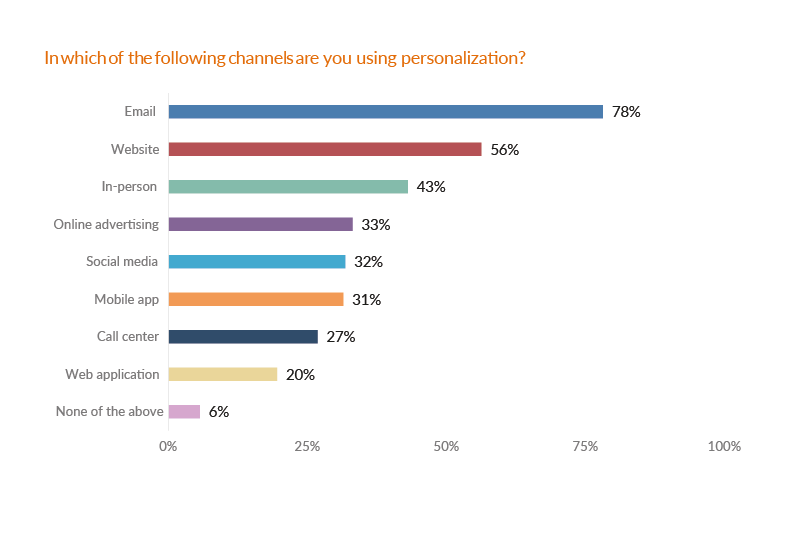What Is Progressive Profiling and Why Do You Need It?
Progressive profiling is a great tool that can help with getting more customer data and getting more out of it.

Having access to accurate and reliable customer data is absolutely essential for virtually any business. Customer data provides companies with crucial intelligence and valuable suggestions on how to identify, approach, and engage leads to make them interested in a product or a piece of content.
And it seems like this will get more and more important in the future. Modern consumers are demanding personalized experiences and they’re certainly getting them. Business and website owners have realized how important personalization is, so if you don’t offer your visitors the same, you’ll be inevitably losing your competitive edge.
Without top-quality customer data, it’s impossible to even begin personalizing your content, messages, and interactions with the users. And progressive profiling can help you overcome many obstacles in gathering useful information about the customers. So what are the most common issues with collecting user data and how can progressive profiling help?
Troubles with collecting user data
It’s definitely not easy to lay your hands on trustworthy, actionable customer data. The best and most straightforward way is definitely letting people tell you who they are, why they’re browsing your website, and what they’re interested in.
It sounds great in theory, but in practice it’s not so easy. There’s probably no person in the world who thinks “oh I can’t wait to fill in this 17-field form asking for a ton of my personal info”. People don’t have the time for that, they often don’t see value in it, and it feels intrusive and unsafe – for a good reason. So they’ll usually just skip this part, or simply leave the website, or even fill out the form with fake info.
Progressive profiling can help you avoid these issues and make the process of sharing personal info easier, smoother, and less annoying for the users. It also gives you an opportunity to build trust first and ask users to fill out the forms afterwards, which substantially increases your chances of obtaining authentic, detailed customer info.
What is progressive profiling?
Progressive profiling is the method of gathering data that entails the gradual collection of data using dynamic web forms. This simply means that you don’t collect all the customer data immediately, but you divide this process into multiple chunks.
For instance, the first time a user visits your website or chooses to download a piece of content, you ask only for their name and e-mail address. Then, next time you have the chance you ask for their location and job position, and then the next time you try to get their company name and phone number.
In theory, you can repeat this as many times as you want, but after 3-4 sets of questions, you’ll probably have most of the info you need. Your marketing team will be able to customize their messaging accordingly, while your sales team will know how to best approach a specific lead and which product to offer.
By dividing this procedure into multiple steps and spreading it over time, you’ll get much more users to fill in these extra-short forms and avoid chasing them away.
It’s also crucial that there are no fields that appear repeatedly, over and over, since this irritates users and looks quite unprofessional. Every piece of data ever inputted is stored into your CRM or other marketing automation tool so there’s no need to ask the same question ever again.
Before talking a bit more about the benefits of progressive profiling, let’s first look into how exactly you should implement this feature and what you should pay special attention to.
How to use progressive profiling?
To successfully implement progressive profiling, you first need to ask yourself these 4 questions:
How to initiate the interaction? Which questions should you ask the user first?
How will the user’s answers to your initial questions affect the choice of questions you’ll ask them next?
Which exact moments will you choose to ask them (more) questions?
How will the user’s answers affect your further actions?
We’ll try to answer these 4 questions with 4 separate paragraphs.
1. Choosing the right opening questions
The first questions should be the most generic ones. Don’t ask too many of them as that would obviously ruin the whole point of progressive profiling. Use no more than 3-4 fields, just to get people to sign up or simply initiate some sort of interaction with your company.
Asking for their name and email is more than enough at this stage. This way the user is making a small, unconscious investment and commitment to your business and this might motivate them to answer more questions in the future.
A consumer that fills in these fields also shows at least a pinch of interest in your product or your company. They’re far from being qualified leads yet, but it’s still something you can work with and you can start nurturing your relationship with this new prospect.
2. Asking and personalizing further questions
The questions you’ll be asking next will depend on how a user answers the first ones. And the way they answer the second batch of questions should also affect your further inquiries.
For instance, an email domain might already tell you something about the user’s workplace. In this case, there’s no need to ask him or her about their company name, but you could ask questions about their role. Or if you ask about their job position, sometimes you can easily deduce which product they could be interested in, so you don’t really have to ask about that.
Moreover, once you find out their name and email, you (or your CRM tool) can pull more of their personal and business info from different social channels. This makes your job even easier and you can now focus on some really specific questions – for instance, whether they already use services from your competitor, what they don’t like about it, or how much they’d be ready to invest in a new solution.
Also, you should avoid confusing and open-ended questions and try to make the process as smooth as possible. Try offering users multiple options they can choose from whenever possible. This will make them more eager to fill in forms and equip you with more definite and accurate customer data.
3. Getting your timing right
We now come to the third problem – how to choose the exact moments to deliver new questions to visitors. This decision should be informed by additional customer behavior info. Any decent CRM software that you integrate with your website should be able to provide you with some very useful data about users’ online behavior.
For instance, it’s very important which pages on your website the user has visited, how much time they spent on each page, and which products they have looked into, and when. Then you can set triggers that’ll ask them the right questions at the exact right moment, based on their activity on your website or the way they react to your email campaigns.
Of course, there are numerous factors and moving parts here so it’s impossible to lay out a one-size-fits-all strategy. You’ll have to devise your own approach and your own specific rules and workflows. Always pay attention to user’s apparent interests, needs, and intentions, as well as their exact place in the customer journey. All these parameters are crucial for determining the best time to ask more questions and successfully proceed with the process of progressive profiling.
4. Determining your further actions based on user’s answers
Now, the whole point of this gradual collection of user data is identifying leads, qualifying them, and engaging them with the right offers and messages.
Hence you need to know in advance what you’re going to do once you have this data. Your marketing and sales automation tool will let you set triggers for different personalized actions you can take based on the obtained info. If you miss the right moment to suggest a piece of content that can propel them further down the sales funnel or suggest a product they may be interested in, that moment might never come back.
So it’s crucial to devise a detailed plan about the exact steps you’ll take once you have the desired data and combine it with the info about the user’s online behavior. It’s the final and most important step in getting the user to convert, and without it, you’ve basically just wasted your time.
Discover How SpotlerCRM Can Help
Benefits of progressive profiling
By far, the most important benefit of progressive profiling is that it makes the process of collecting customer info easier, more efficient, and more streamlined. There are multiple reasons why that is so:
With shorter forms and fewer fields, it’s much easier to convince people to share their data. At the end of the day, conversion rates speak for themselves. Reducing the number of fields from 11 to 4 increases conversions by a stunning 120%. Moreover, another research showed that conversion rates with 3 fields stand at the 25% mark, but with 6+ fields this rate drops to only 15%.
And when you think about it, it makes perfect sense that progressive profiling will improve your conversions and sales. Namely, some of the users who decide to leave may have been truly interested in your product but they were simply put off by the huge forms they had to fill in to find out more about it.
Progressive profiling substantially improves user and customer experience. Much fewer people will leave your website to never come back and your bounce rate will surely decrease thanks to this strategy.
Your company will seem more professional and trustworthy. Firstly, you’ll avoid looking intrusive and overly nosy. Also, you’ll get points if you first offer valuable content and useful info to your users before asking for something in return. Visitors will respect that you waited for them to show genuine interest in your website or your product before trying to get their detailed info.
Final thoughts
Progressive profiling is a great tool that can help you with getting more customer data and getting more out of it. The utility of customer data is massive and diverse. It helps you qualify leads, deliver personalized content and messages, get familiar with your customers and their needs and interests, and substantially accelerate the buyer’s journey.
Of course, in order to collect this crucial data and use it to your advantage, you’ll need more than just progressive profiling. You also need a broader data collection strategy, reliable CRM software that will help you execute it, a website that offers top-quality UX, as well as a truly good product that can attract consumers in the first place.
Progressive profiling is just a neat little trick that can definitely help you succeed in these attempts. Don’t miss out on the opportunity to use it.
Really Simple Systems is now Spotler CRM
The same great technology, a CRM platform that is focused on the needs of B2B marketers, provided by the same great team, at a great price!


